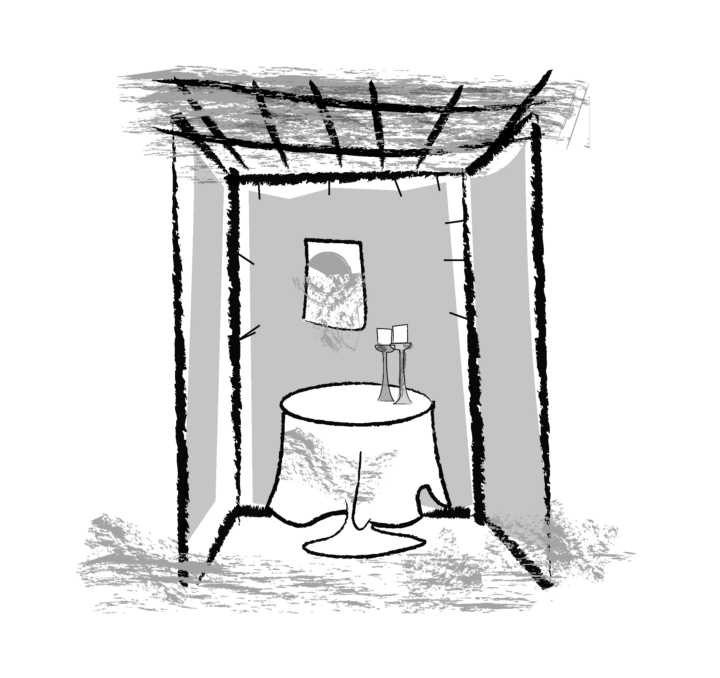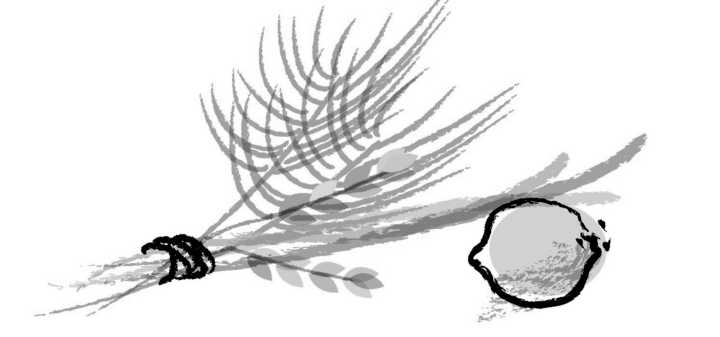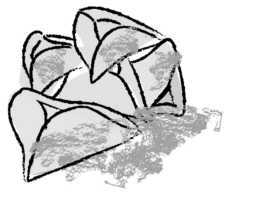Jewish Cooking Boot Camp: The Modern Girl's Guide to Cooking Like a Jewish Grandmother (22 page)
Read Jewish Cooking Boot Camp: The Modern Girl's Guide to Cooking Like a Jewish Grandmother Online
Authors: Andrea Marks Carneiro
Tags: #Cookbooks; Food & Wine, #Entertaining & Holidays, #Special Diet, #Kosher, #Special Occasions, #Religion & Spirituality, #Judaism


Obviously, Judaism consists of much more than the holidays mentioned thus far in this book.
There is an entire calendar full of holidays that, unfortunately, we weren't able to cover in
depth (hello, sequel!). Below we've given you a brief overview of some other major holidays on
the Jewish calendar, along with some fun facts and tips for celebrating.
Sukkot falls immediately after Yom Kippur and, though following one of the most serious
and solemn holidays, is all about rejoicing. In fact, it is often referred to as the "Season of
our Rejoicing," or Z'man Simchateinu. The idea behind the celebration is one part historical
and one part agricultural, as it not only commemorates the years spent wandering in the
desert but also acts as a harvest festival. Below are a few fast facts about Sukkot:
• Sukkot means "booths," and refers to the temporary shelters Jews were commanded to live
in during their period of wandering.
• A main part of the holiday revolves around building and decorating a sukkah (great fun
for the kids!) with everything from fruits and vegetables (usually dried squash and corn)
to children's artwork.
• A sukkah must have at least two-and-a-half walls covered with material that will not blow
away in the wind, and a roof made from sekhakh (meaning "covering"). The sekhakh needs
to be something that came from the ground (such as branches, cornstalks, bamboo, etc.).
The sekhakh should be left loose and be sparse enough that rain can get through but not
sparse enough that there is more light than shade.
• Observant Jews are encouraged to spend as much time as possible in the sukkah (including sleeping in it!), but the idea of "dwelling" in the sukkah can be simply eating all of one's
meals inside it.
• It's no coincidence that Sukkot is reminiscent of Thanksgiving. Some believe that the
Pilgrims based the holiday on Sukkot.
• Another major observance is the use of the lulav and etrog. The lulav consists of a palm
branch, two willow branches, and three myrtle branches. The etrog is a citrus fruit similar to a lemon and is native to Israel. Holding each in one hand, they are brought together
and are waved in six directions (north, south, east, west, up, and down) to recognize that
God is everywhere.

• One of the most interesting traditions of Sukkot (at least in our opinion) is that of the
Ushpizin, or Seven Guests. For each of the seven nights of the holiday, Jews are encouraged to "invite" leaders of historical importance to join them in the sukkah. The traditional invitees are Abraham, Isaac, Jacob, Joseph, Moses, Aaron, and David, and they are
considered, for the night, to be the most honored guest.
Simchat Torah follows Sukkot on the Jewish calendar as another celebratory holiday. Each
week in temple, Jews read passages from the Torah, starting with Genesis and ending
with Deuteronomy. Simchat Torah celebrates the reading of the last chapter, which is then immediately followed by Genesis once again. It reminds congregants that the Torah is
never-ending. A few more facts:
• The holiday is observed with a fun, high-spirited celebration. The ark that houses the
Torahs is opened, all the Torahs are removed, and the congregants participate in a processional around the synagogue filled with dancing, singing, and prayers.
• As many people as possible are called for an aliyah, or blessing over the Torah reading,
even children who are normally too young to receive one.
• Simchat Torah is a wonderful family holiday, as children are encouraged to run around
with small (sometimes plush) Torahs in the synagogue and general craziness is accepted.
• Drinking is not uncommon during this holiday; aside from Purim, it is the holiday most
associated with alcohol according to most texts.
Anyone who ever made his or her way through Jewish day school (or Hebrew school, for that
matter) knows this holiday as the "tree holiday," and that's precisely what it is: a New Year's
for Trees. It acts as a specific date to calculate the age of trees, as the Torah states that the
fruit of the trees cannot be eaten for the first three years and the fourth year the fruit is
reserved for God. More facts:
• Many celebrate this holiday by planting a tree, eating a new fruit, or collecting money to
plant trees in Israel.
• It is customary to eat fruits that remind us of Israel including grapes, olives, dates, figs,
and pomegranates. The blessing over fruit is said: Baruch atah A-donoy, Elo-heinu Melech
Ha'Olam borei pri ha-aitz; Blessed are You, Lord our God, King of the universe, who creates the fruit of the tree.
Purim is truly a holiday of fun and celebration. It is based around the Book of Esther (or
Megillah Esther) and tells the story of how the Jewish people were delivered from the ancient
Persian empire when King Ahausuerus's royal advisor, Haman, planned to massacre them.
In the story, the beautiful Esther becomes queen, though the King does not know that she
is a Jew. Upon the advice of her cousin Mordecai, she approaches the King (a dangerous act)
and tells him of Haman's plot against her people, thus saving the Jews from extermination.
More facts:
• The Book of Esther is believed to be the only book of the Bible that does not contain the
name of God. In fact, there is little or no reference to God at all.
• It is celebrated on the fourteenth day of Adar (usually falling in March), the day the Jews
celebrated their survival.
• The holiday is preceded by The Fast of Esther, in which we commemorate Esther's threeday fast prior to meeting with the King.
• During the reading of the Megillah it is customary to shout, boo, stomp, and shake noisemakers when the name "Haman" is mentioned.
• On Purim, drinking is encouraged. In fact, there are many conflicting opinions on just
how drunk one is commanded to get on the holiday ... but we'll leave that up to your own
research and good judgment!
• Jews are also commanded to send food and gifts and to make gifts to charity. The custom is known as Matanot LaEvyonim, and specifies that a minimum of two gifts be
given to people in need. The gift should be given during the day and can come either
directly or through a third party.
• It is customary to hold celebrations, perform plays, and dress up as characters from the
story of Purim.
• The Jewish women's organization Hadassah was named for Queen Esther when it was
founded in 1912, as Hadassah is Hebrew for Esther.
Hamantaschen are the traditional pastry of Purim. Their three-sided shape is sometimes
thought to be modeled on Haman's hat and even has a song associated with it:
My hat it has three corners. Three corners has my hat. And had it not three corners,
It wouldn't be my hat. Clever, no? This recipe comes courtesy of my very good friend, the lovely
Deborah Edell, owner of Perry Street Cakes in New York City.
PREPARATION TIME: ABOUT 1/2 HOUR PLUS 2 HOURS TO CHILL THE DOUGH
COOKING TIME: 20-25 MINUTES PER BATCH

1. In a medium bowl, whisk together the flour, baking powder, and salt. Set aside. In a large
mixing bowl, beat the butter until smooth. Add the sugar and beat until fluffy. Add the egg
and beat until just incorporated.
2. Add the juice and vanilla. Beat until smooth.
3. Gradually add the flour mixture until well incorporated. You may wish to transfer the
dough to a floured surface and knead it until smooth, but this is not necessary.
4. Divide the dough into 2 balls and wrap in plastic. Refrigerate for at least 2 hours.
5. Preheat the oven to 350°F. Lightly grease two cookie sheets, so you can prepare one while
the other bakes.
6. Remove one of the balls of dough from the fridge and roll out on a lightly floured surface with a rolling pin to about %8 inch thick. (Or you can roll out the dough between two
sheets of plastic.) Using a 3-inch round cookie cutter or the rim of a drinking glass, cut
out rounds. Re-roll any scraps.
7. Spoon a heaping teaspoon full of jam into the center of each round of pastry. Using your
fingers, pinch the edges of the dough together around the filling to form a triangle. Pinch
the edges tightly at each corner so that the filling stays in the cookie.
